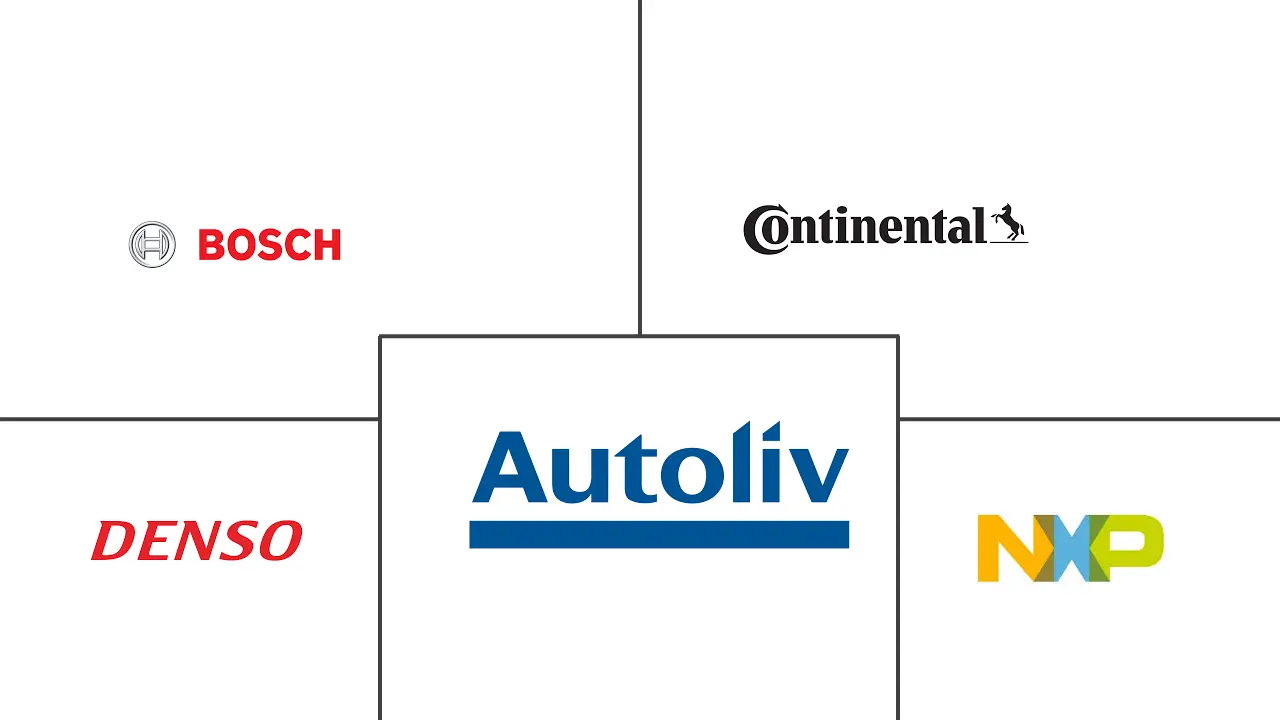Automotive Radar Market Size and Share
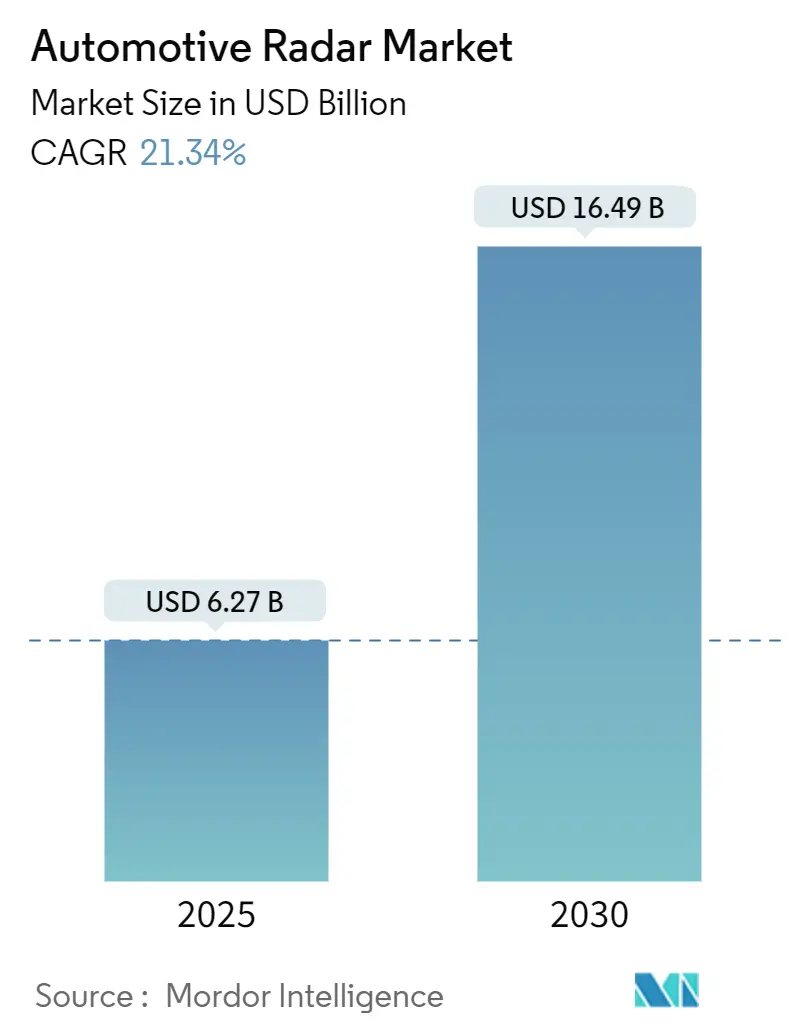
Automotive Radar Market Analysis by Mordor Intelligence
The automotive radar market stands at USD 6.27 billion in 2025 and is on course to reach USD 16.49 billion by 2030, advancing at a 21.34% CAGR. Growth is propelled by tightening global safety regulations that mandate automatic emergency braking and vulnerable-road-user protection, together with the rapid rollout of Level-2+ autonomy packages that rely on multi-radar perception suites. High-frequency packaging breakthroughs are shrinking sensor footprints and slashing bill-of-materials costs, making radar viable for volume vehicle segments. Asia-Pacific remains the largest and fastest-expanding production center as 76-79 GHz compliance rules and electric-vehicle (EV) architectures provide thermal headroom for additional sensors. Meanwhile, long-range and imaging radar technologies are moving from premium models into mass platforms, supplying the vision-redundancy layer needed for highway automation and traffic-jam pilot features.[1]National Highway Traffic Safety Administration, “Federal Motor Vehicle Safety Standard No. 127: Automatic Emergency Braking Systems for Light Vehicles,” nhtsa.gov
Key Report Takeaways
- By range, medium-range radar held 57.60% revenue share in 2024, while long-range systems expand at a 21.70% CAGR through 2030.
- By frequency band, the 77 GHz category accounted for 54.20% of the automotive radar market share in 2024; 79 GHz-and-above bands register the fastest CAGR at 22.40%.
- By propulsion, battery-electric vehicles captured 46.50% of the automotive radar market size in 2024 and are advancing at a 21.60% CAGR to 2030.
- By application, adaptive cruise control led with 35.17% share in 2024, whereas occupancy and driver monitoring systems post a 23.20% CAGR.
- By geography, Asia-Pacific commanded 41.02% of 2024 revenues and is growing at 22.10% CAGR through 2030.
- By sales channel, OEM-fitted units dominated with a 78.12% share in 2024.
- Top-five suppliers collectively controlled 83% of 2024 revenues.
Global Automotive Radar Market Trends and Insights
Drivers Impact Analysis
| Driver | (~) % Impact on CAGR Forecast | Geographic Relevance | Impact Timeline |
|---|---|---|---|
| Stringent NCAP and UNECE safety mandates | +4.2% | Europe & North America first movers; global rollout | Medium term (2-4 years) |
| 77 GHz cost-driven miniaturisation wave | +3.8% | Asia-Pacific manufacturing hubs | Short term (≤2 years) |
| Mass-market Level-2+ autonomy adoption | +5.1% | North America & Europe; scaling in Asia-Pacific | Medium term (2-4 years) |
| EV architecture headroom for added sensors | +2.9% | EV-leading regions worldwide | Long term (≥4 years) |
| Emerging 4D imaging radar for redundancy | +3.4% | Premium vehicle programs globally | Medium term (2-4 years) |
| Chiplet-based radar SoCs for retrofit market | +1.9% | Mature fleets in developed economies | Long term (≥4 year |
| Source: Mordor Intelligence | |||
Stringent NCAP and UNECE Safety Mandates
Stricter consumer-rating and regulatory frameworks are anchoring demand for next-generation radar. NHTSA’s Federal Motor Vehicle Safety Standard 127 will require automatic emergency braking with pedestrian detection from September 2029, obliging every light vehicle to field front radar capable of reliable detection at speeds above 10 km/h in day and night.[2]National Highway Traffic Safety Administration, “Federal Motor Vehicle Safety Standard No. 127: Automatic Emergency Braking Systems for Light Vehicles,” nhtsa.govEuro NCAP has upgraded its star-rating criteria to reward child-presence detection, pulling interior short-range radar into mainstream family cars.[3]Euro NCAP, “Child Presence Detection Test and Assessment Protocol v1.2,” euroncap.com UNECE guidance for automated driving endorses multi-sensor redundancy, pushing OEMs to pair cameras with imaging radar for high-resolution perception UNECE. Because OEM marketability, insurance premiums and resale values now hinge on meeting these protocols, radar fit-rates keep rising even when macroeconomic cycles soften. The compressed compliance timeline makes radar a must-have line-item across entry, volume and premium trims, transforming it from optional extra to standard equipment.
77 GHz Cost-Driven Miniaturisation Wave
Packaging innovation around the 77 GHz band is shrinking sensor modules and opening cost tiers suited to high-volume vehicles. Texas Instruments’ single-chip AWR2544 integrates transmitter, receiver and digital front-end inside a launch-on-package design that is 30% smaller than earlier modules yet still detects targets beyond 200 m. NXP’s TEF810x further condenses three transmitters, four receivers and the mixers needed for frequency-modulated continuous-wave (FMCW) operation onto a single die.[4]NXP Semiconductors, “77 GHz Radar Transceiver TEF810x,” nxp.comThese advances permit 360-degree coverage using satellites of small, low-cost sensors connected via gigabit automotive Ethernet to a central processor. As component counts rise from one to as many as five radar units per mass-segment car, economies of scale drive wafer starts at IDMs and foundries higher, accelerating cost erosion and reinforcing the price-performance edge of radar over lidar.
Mass-Market Level-2+ Autonomy Adoption
OEM roadmaps show Level-2+ systems moving from luxury segments into the upper-middle mainstream. Highway assist, automated lane-change and traffic-jam pilot require fusion of at least three radars to achieve redundancy at distances beyond 200 m and 180-degree side coverage. Aptiv’s sixth-generation ADAS platform couples radars with vision to enable over-the-air activation of hands-free highway driving, validating subscription-based revenue models. As software-defined architectures proliferate, automakers can unlock dormant radar features post-sale, smoothing price acceptance. Analyst projections indicate an average of 1-3 radars per passenger car by 2030, with robotaxis carrying up to 10. The scale lift translates directly into silicon demand for RF front ends, baseband processors and power management ICs, reinforcing the growth trajectory of the automotive radar market.
Emerging 4D Imaging Radar for Vision-Redundancy
Fourth-generation imaging radar resolves multiple elevation slices, producing near-lidar-grade point clouds even in fog, glare or rain. Arbe Robotics’ ultra-high-definition unit deploys 48 transmit and 48 receive channels, yielding tens of thousands of detection points per frame for robust object classification. Aptiv’s 4D system captures height information, allowing automated vehicles to navigate underpasses and overhanging obstacles that can confound cameras. Ambarella links imaging radar to centralized AI processing, reducing sensor count while elevating decision accuracy. Premium OEMs view 4D radar as the insurance layer that keeps automated functions alive when optical sensors falter, and they are willing to pay a price premium for the fail-operational capability. As volumes climb and die sizes fall, 4D radar is projected to migrate into upper-mainstream models by late decade.
Restraints Impact Analysis
| Restraint | (~) % Impact on CAGR Forecast | Geographic Relevance | Impact Timeline |
|---|---|---|---|
| High multi-sensor fusion system cost | -2.1% | Price-sensitive emerging markets | Short term (≤2 years) |
| Spectrum congestion at 79 GHz | -1.8% | Dense urban areas within developed economies | Medium term (2-4 years) |
| Thermal bottlenecks in legacy GigE backbones | -1.3% | Cars with older electrical architectures | Medium term (2-4 years) |
| SiGe/GaAs wafer supply constraints | -2.4% | Global; fabrication centred in Asia-Pacific | Short term (≤2 years) |
| Source: Mordor Intelligence | |||
High Multi-Sensor Fusion System Cost
Merging radar, camera and optional lidar streams demands powerful domain controllers priced near USD 1,000 per Level-3-ready vehicle, elevating the bill of materials particularly in price-sensitive B- and C-segment cars. Beyond silicon, OEMs must finance vast datalogging campaigns and validation cycles to certify fusion algorithms under NCAP and UNECE protocols. Smaller automakers lack the engineering depth of global majors, compelling them to buy turnkey stacks from tier-1s at premium pricing. Although chiplet-based designs promise step-down cost curves, they will not scale until volume 2027 model launches. In emerging markets with lower mandated safety content, the upfront hike hampers radar penetration and slows the otherwise steep trajectory of the automotive radar market.
Spectrum Congestion at 79 GHz in Key Regions
Urban corridors now teem with 76-81 GHz radars on passenger cars, delivery vans and test robotaxis. NHTSA field trials reveal that simultaneous transmissions can lift interference above acceptable thresholds, cutting detection ranges by more than 20 m in bumper-to-bumper traffic. ETSI highlights potential clashes with radio-astronomy bands, forcing talk of exclusion zones or adaptive power limits in parts of Europe ETSI. Digital beamforming offers relief but drives up compute load and cost. Without harmonized mitigation standards, OEMs may be compelled to tune region-specific firmware or revert to lower-density radar topologies in congested cities, tempering growth momentum where safety features are most valuable.
Segment Analysis
By Range: Extended Detection Spurs Long-Range Adoption
Medium-range units held 57.60% of the automotive radar market size in 2024, underpinning cornerstone functions such as adaptive cruise control and automatic emergency braking. Still, the long-range category is growing at 21.70% CAGR as Level-2+ highway pilot demands 200 m forward sensing for lane-change confirmation and cut-in prediction. Centralized zone architectures let OEMs combine multiple compact sensors to stitch a continuous field of view, reducing blind spots while tapping economies of scale. Long-range modules now integrate digital code modulation that widens unambiguous velocity windows, critical for detecting motorcycles and fast-closing vehicles. The design shift enlarges aperture size and power-handling needs, but EV powertrains afford the electrical margin, accelerating uptake in premium and upper-mainstream trims across Asia, Europe and North America.
Short-range and ultra-short-range devices remain vital for cross-traffic alert, parking assist and cabin monitoring yet face cost-down pressure from camera ultrasonic hybrids. Over the forecast window, the mix skews toward multiple-range deployments per car, lifting total sensor counts and reinforcing the scale economics of the automotive radar market. Supply-side innovations in multilayer organic substrates and wafer-level chip-scale packaging further narrow the price gap between long- and medium-range products, sustaining double-digit expansion even after core safety functions become standard.
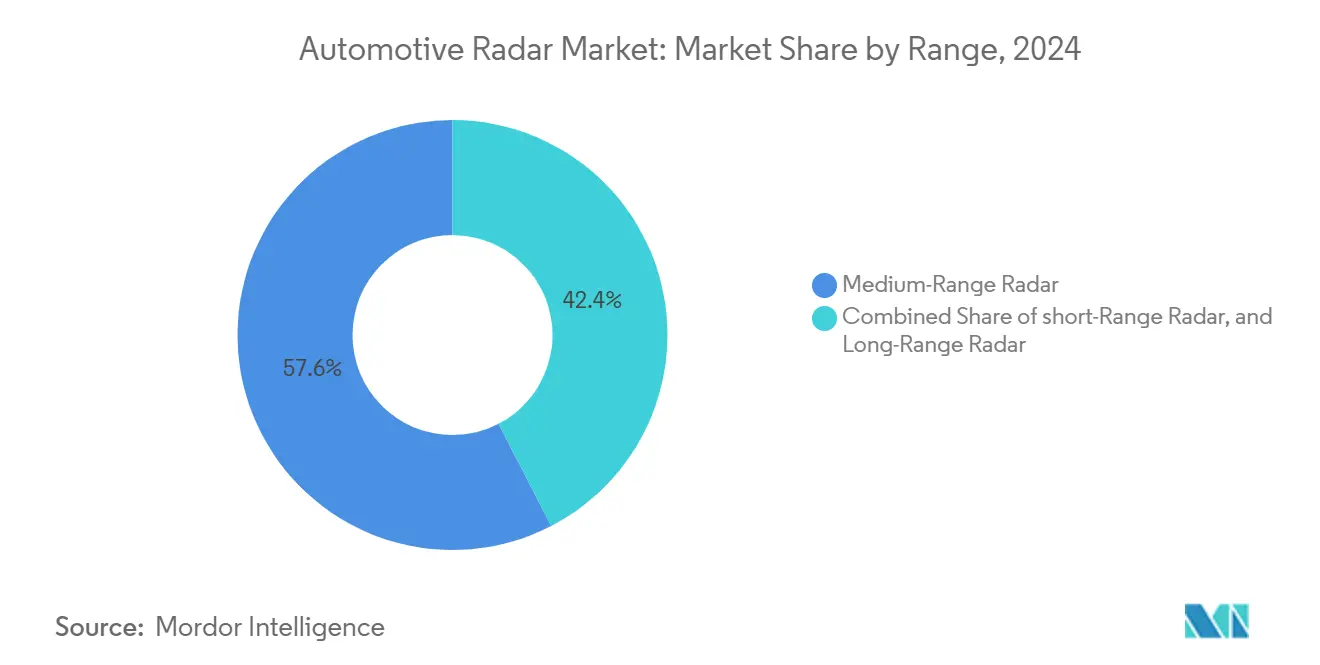
Note: Segment shares of all individual segments available upon report purchase
By Frequency Band: Transition to 79 GHz Gains Momentum
The 77 GHz spectrum owned 54.20% of 2024 revenues, benefiting from standardized test procedures and mature foundry flows. Yet 79 GHz systems are accelerating at 22.40% CAGR. Higher-end frequency unlocks finer range resolution and permits wider unlicensed bandwidth, crucial for imaging radar. China’s MIIT mandate that all new radar units operate in 76-79 GHz has effectively sunset the 24 GHz band, compressing the transition timeline. Europe’s recent implementing decision aligns its channels, removing regulatory ambiguity and clearing a path for continent-wide 79 GHz deployment.
Processing complexity rises with bandwidth, so tier-1s partner with semiconductor vendors to co-optimise RF and AI workloads. NXP’s S32R47 imaging processor doubles MAC throughput while trimming power budgets, easing the thermal burden inside tightly packed bumper modules. Over time the automotive radar industry expects a bimodal portfolio: 77 GHz for cost-optimised mid-range sensing and 79 GHz for high-definition perception, with die-level pin-compatibility enabling OEMs to scale features by trim line.
By Application: Interior Radar Outpaces Legacy ADAS
Adaptive cruise control retained 35.17% share in 2024 and will remain the anchor application through mid-decade as more mass-segment cars adopt ACC as standard. Nevertheless, interior occupancy and driver monitoring solutions deliver the fastest climb at a 23.20% CAGR. Euro NCAP’s 2026 roadmap awards additional points for direct child-presence detection, prompting OEMs to position ultra-short-range radar behind headliners for non-line-of-sight breathing sensing. Beyond safety, in-cabin radar supports gesture control and robbery-prevention intrusion alerts, expanding the revenue canvas.
Automatic emergency braking, blind-spot monitoring and rear cross-traffic alert comprise the middle tier of growth contributors. Collectively they cement the value proposition that radar detects metallic and non-metallic obstacles reliably in rain, snow or low-sun glare. As software-defined frameworks proliferate, OEMs will over-the-air enable new modes such as road-edge detection or pothole profiling, spreading fixed hardware investment across the vehicle life and supporting sustainable expansion of the automotive radar market.
By Vehicle Type: Robotaxi Sensor Density Multiplies Demand
Passenger cars generated 72.04% of 2024 revenues because of sheer unit volume, yet robotaxis and autonomous shuttles lead CAGR charts at 24.10%. Commercial ride-hailing fleets require fail-operational redundancy, often installing 8-10 radars to cover 360 degrees with overlapping fields. The business case tolerates higher sensor bills provided the systems unlock driver-out capex savings. Light commercial vehicles adopt radar for collision-mitigation and insurance-rate discounts, particularly among last-mile delivery operators whose urban duty cycles expose them to vulnerable road users.
Heavy trucks integrate forward mid- and long-range radar for adaptive platooning and highway pilot programs, easing driver fatigue over long hauls. Across categories, standardisation on 76-81 GHz bands simplifies supplier tool chains and lets integrators amortise validation costs. The escalating sensor count per platform directly fuels the automotive radar market, even if total vehicle sales plateau in mature regions.
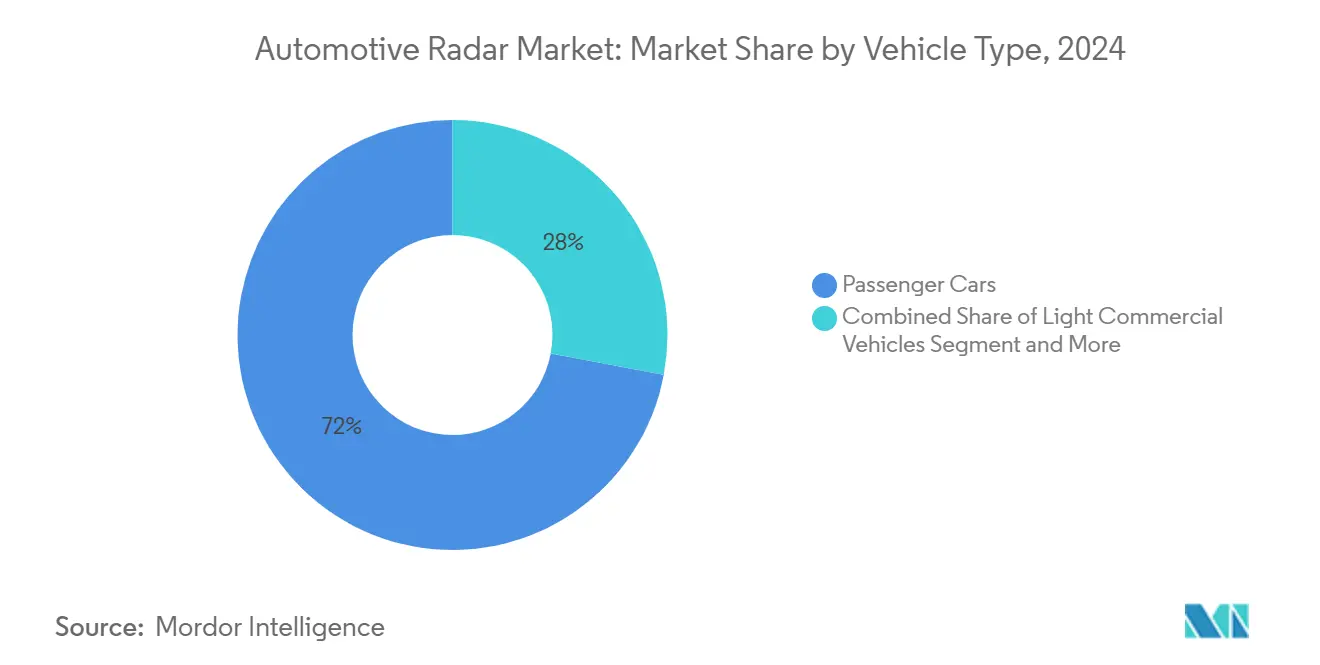
Note: Segment shares of all individual segments available upon report purchase
By Propulsion: EV Electrical Headroom Spurs Radar Proliferation
Passenger cars generated 72.04% of 2024 revenues because of sheer unit volume, yet robotaxis and autonomous shuttles lead CAGR charts at 24.10%. Commercial ride-hailing fleets require fail-operational redundancy, often installing 8-10 radars to cover 360 degrees with overlapping fields. The business case tolerates higher sensor bills provided the systems unlock driver-out capex savings. Light commercial vehicles adopt radar for collision-mitigation and insurance-rate discounts, particularly among last-mile delivery operators whose urban duty cycles expose them to vulnerable road users.
Heavy trucks integrate forward mid- and long-range radar for adaptive platooning and highway pilot programs, easing driver fatigue over long hauls. Across categories, standardisation on 76-81 GHz bands simplifies supplier tool chains and lets integrators amortise validation costs. The escalating sensor count per platform directly fuels the automotive radar market, even if total vehicle sales plateau in mature regions.
By Sales Channel: OEM Integration Remains Dominant
Factory-fitted installations captured 78.12% share in 2024 because homologation rules favour components validated across full vehicle-life environmental tests. Radar’s safety-critical role makes insurers and regulators wary of post-sale kits. Still, chiplet-based reference designs that separate the RF head from a remote processor over gigabit Ethernet cut retrofit complexity. Commercial fleet operators exploring driver-out retrofits for depots may open a modest aftermarket niche from 2027 onward.
Tier-1 suppliers court OEMs with modular, software-upgradable radars that share housings and connectors across model lines. That interchangeability speeds design cycles and cements the long-term dominance of factory integration, ensuring that OEM channels continue to anchor the automotive radar market over the forecast period.
Geography Analysis
Asia-Pacific accounts for 41.02% of 2024 revenues and records a 22.10% CAGR, making it the pivotal region for the automotive radar market. China enforces 76-79 GHz conformity and State Radio regulatory certification, compelling local OEMs and global joint ventures to standardise on high-frequency radar. The country’s EV penetration now exceeds 30% of new-car sales, providing ideal electrical infrastructure for multi-sensor platforms. Japan and South Korea contribute strong semiconductor ecosystems; domestic IDMs supply SiGe and CMOS RF dies that shorten lead times for regional assembly plants. Government grants aimed at robotaxi pilots around Seoul and Tokyo encourage imaging radar uptake in shared-mobility prototypes.
Europe sustains second-largest share on the back of historical safety leadership. Euro NCAP’s 2026 protocols, Germany’s investment incentives for Level-3 autobahn pilots and the European Commission’s spectrum harmonisation decisions preserve a stable demand floor. Premium brands headquartered in Germany and Sweden spearhead 4D radar adoption to maintain high-end brand perception. Supply security initiatives under the Chips Act are expected to subsidise new 300-mm automotive RF fabs, easing exposure to Asian wafer capacity constraints.
North America benefits from the September 2029 federal AEB mandate that makes forward radar obligatory across all light vehicles, ensuring a steady climb in fit rates. The continent’s long highway corridors favour long-range radar and high-speed ACC. U.S. silicon vendors specialise in mixed-signal radar SoCs, integrating baseband and AI accelerators that underpin domestic competitiveness. Cross-border coordination with Mexican wire-harness plants and Canadian module integrators secures cost-effective supply for Detroit Three and transplant OEMs.
Middle East and Africa start from a smaller base yet show rising adoption in luxury imports and regional EV assembly projects. South America, with Brazil at the helm, mandates electronic stability control across passenger vehicles and is weighing AEB requirements similar to U.S. rules, suggesting a ramp in radar demand later in the decade. Across all regions, local regulations, infrastructure and manufacturing footprints combine to shape a globally diffused, yet still synchronised, growth path for the automotive radar industry.
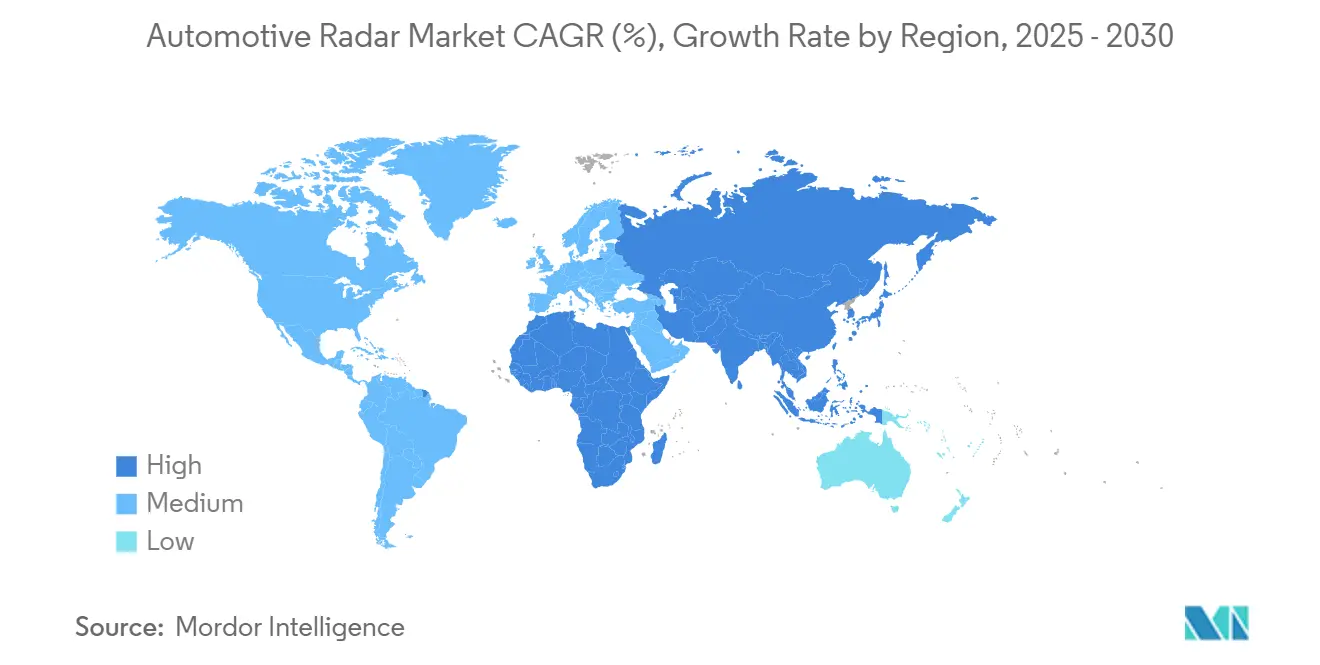
Competitive Landscape
Market concentration is moderate: the top five vendors controlled 83% of 2024 revenue, led by Bosch, Continental, DENSO, Texas Instruments and NXP. Their advantage stems from functional-safety pedigree, ISO 26262 processes and entrenched OEM design-wins. Bosch ships more than 200 million radar sensors cumulatively and converts scale economies into competitive pricing, while Continental leverages its ARS540 4D platform in multiple German premium brands.
Challengers innovate around digital signal chains. Uhnder’s digital code modulation radar transmits orthogonal codes to cut mutual interference and has begun series production with a Tier-1 partner. Arbe pairs 48×48 MIMO arrays with NVIDIA’s DRIVE AGX Orin to deliver lidar-like point clouds, capturing early robotaxi contracts. Vayyar stretches radar usage beyond ADAS into cabin health monitoring, smart-child seats and motorcycle blind-spot detection, diversifying the addressable market.
Strategic plays centre on silicon-software synergies. Infineon’s acquisition of Imagimob strengthens embedded machine-learning for edge radar classification. TI collaborates with Tier-1s on zone-controller reference designs that fuse four satellite radars into a central processor running on Sitara ARM cores. NXP aligns its S32 platform roadmap to support OTA upgradable safety stacks, promising feature updates without hardware swaps. As imaging radar software weight climbs, vendors with GPU or DSP co-processors gain leverage, ushering in a race between mixed-signal incumbents and AI-centric newcomers for algorithm supremacy across the automotive radar market.
Automotive Radar Industry Leaders
-
Robert Bosch GmBH
-
Continental AG
-
Denso Corporation
-
Autoliv
-
NXP Semiconductors
- *Disclaimer: Major Players sorted in no particular order
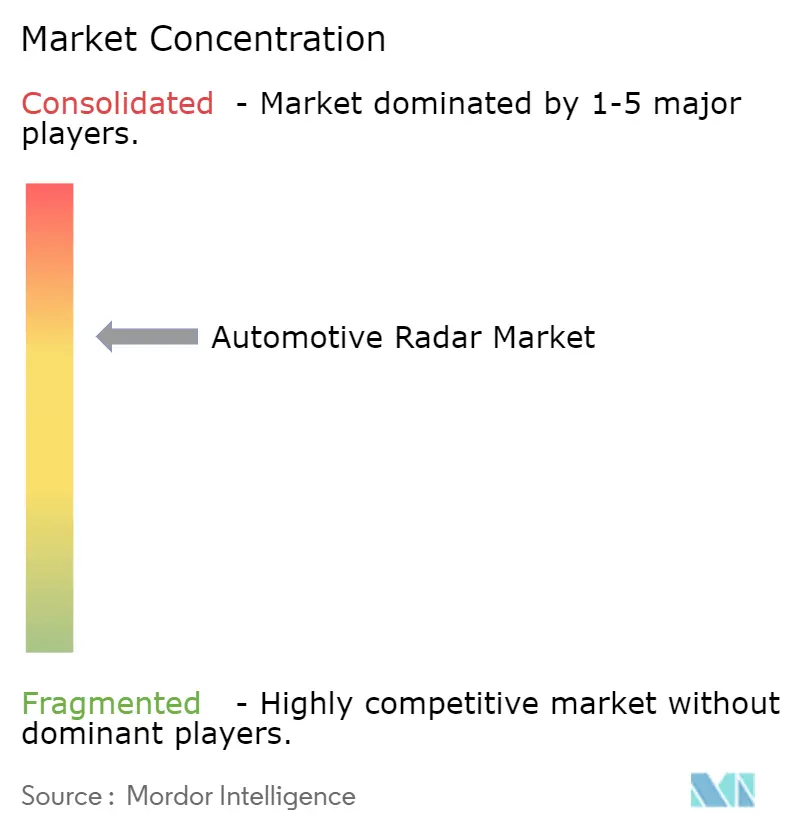
Recent Industry Developments
- March 2025: NXP reported automotive revenue of USD 7.15 billion for 2024, citing strong demand for ADAS radar transceivers
- January 2025: HTSA issued its New Car Assessment Program final decision notice adding blind-spot warning, lane-keeping assist and pedestrian AEB to the 2026 model-year evaluation slate, elevating radar content in mainstream vehicles
- January 2025: Arbe Robotics announced collaboration with NVIDIA to enhance radar-based free-space mapping capabilities, integrating its 48 × 48 MIMO radar with the DRIVE AGX platform to improve real-time perception for autonomous driving
- November 2024: NHTSA published Federal Motor Vehicle Safety Standard 127 mandating radar-based AEB with pedestrian detection by September 2029
Research Methodology Framework and Report Scope
Market Definitions and Key Coverage
Our study defines the automotive radar market as all on-board radio-frequency sensors (24 GHz, 76-81 GHz, and emerging 120 GHz units) factory-installed on passenger and commercial vehicles to power safety and automated-driving functions such as adaptive cruise control, automatic emergency braking, blind-spot monitoring, occupancy detection, and in-cabin gesture control.
Scope exclusion: Military ground radars, aftermarket speed-trap devices, and non-vehicle industrial radars sit outside our scope.
Segmentation Overview
- By Range
- Short-Range Radar (SRR)
- Medium-Range Radar (MRR)
- Long-Range Radar (LRR)
- By Frequency Band
- 24 GHz
- 77 GHz
- 79 GHz and Above
- By Application
- Adaptive Cruise Control (ACC)
- Automatic Emergency Braking (AEB)
- Blind-Spot/Rear Cross-Traffic
- Occupancy and Driver Monitoring
- Autonomous Driving (L3+)
- Parking Assistance and Automated Parking
- By Vehicle Type
- Passenger Cars
- Light Commercial Vehicles
- Heavy Commercial Vehicles
- Robotaxis and AV Shuttles
- By Propulsion
- Internal-Combustion Vehicles
- Battery-Electric Vehicles
- Hybrid-Electric Vehicles
- By Sales Channel
- OEM-Fitted
- Aftermarket Retrofits
- By Geography
- North America
- United States
- Canada
- Mexico
- South America
- Brazil
- Argentina
- Rest of South America
- Europe
- Germany
- France
- United Kingdom
- Italy
- Spain
- Russia
- Rest of Europe
- Asia-Pacific
- China
- Japan
- South Korea
- India
- ASEAN
- Australia and New Zealand
- Rest of Asia-Pacific
- Middle East and Africa
- Middle East
- Africa
- North America
Detailed Research Methodology and Data Validation
Primary Research
Interviews with millimeter-wave chip architects, Tier-1 module engineers, and OEM ADAS planners across Asia, Europe, and North America enabled us to validate sensor counts per vehicle, track ASP roadmaps, confirm regulatory timing, and resolve data gaps revealed during secondary research.
Desk Research
We began with public datasets that quantify the vehicle base, notably OICA production volumes, ACEA new-registration files, and China MIIT new-energy statistics, which are then paired with radar-fitment evidence from Euro NCAP test logs, NHTSA AEB rule dockets, UNECE WP.29 minutes, and UN Comtrade import codes 852691/852692. Trade bodies such as CLEPA and JASIC, plus company 10-Ks and press releases accessed through Dow Jones Factiva and D&B Hoovers, supplied cost, technology, and competitive signals. The sources cited are illustrative; many additional references were consulted by Mordor analysts to verify and clarify the data landscape.
Market-Sizing & Forecasting
Our model starts top-down. Regional light- and heavy-vehicle builds are multiplied by verified radar penetration ratios, which are then converted to revenue through weighted average selling prices split by band and range. Supplier roll-ups and sample OEM bill-of-material checks provide a bottom-up reference that lets Mordor fine-tune totals whenever mismatches emerge. Key variables include vehicle output, sensors-per-car, battery-electric share, mandated AEB deadlines, ASP deflation, and packaging yields. A multivariate regression with scenario analysis projects these drivers to 2030.
Data Validation & Update Cycle
Outputs undergo automated variance scans, peer reviews, and lead-analyst sign-off. We refresh every twelve months, and interim updates are issued when major legislation, M&A, or supply shocks change the baseline, so clients always receive the latest view.
Why Mordor's Automotive Radar Baseline Commands Reliability
Published estimates often diverge because firms pick different radar definitions, vehicle cohorts, pricing curves, and refresh cadences. Our method makes those levers explicit for buyers.
Key gap drivers include some publishers limiting scope to factory-fitted 77 GHz modules, others applying aggressive ASP compression, and a few projecting revenue from installed base rather than new builds, which inflates totals relative to Mordor Intelligence.
Benchmark comparison
| Market Size | Anonymized source | Primary gap driver |
|---|---|---|
| USD 6.27 B | Mordor Intelligence | N/A |
| USD 5.36 B | Global Consultancy A | Excludes 24 GHz shipments; shorter base period |
| USD 7.68 B (2024) | Industry Insight B | Counts aftermarket retrofits plus chip revenue |
In sum, our balanced penetration logic, transparent variables, and annual review cycle give decision-makers a dependable baseline they can trace and replicate with confidence.
Key Questions Answered in the Report
What is the current size of the automotive radar market?
The automotive radar market is valued at USD 6.27 billion in 2025 and is projected to hit USD 16.49 billion by 2030
Which region leads automotive radar adoption?
Asia-Pacific leads with 41.02% revenue share in 2024 and shows the fastest growth at a 22.10% CAGR.
Why are 79 GHz radars gaining traction?
Higher-frequency 79 GHz designs deliver finer resolution and better interference immunity, enabling 4D imaging radar for advanced autonomous functions.
How many radars will an average Level-2+ vehicle use by 2030?
Industry roadmaps indicate 1-3 radars per passenger vehicle, with robotaxis deploying up to 10 for full 360-degree redundancy.
What impact will the U.S. AEB mandate have on radar demand?
NHTSA’s rule effective September 2029 requires radar-enabled automatic emergency braking on every light vehicle sold in the United States, guaranteeing sustained volume growth.
Page last updated on:
